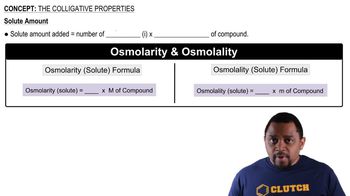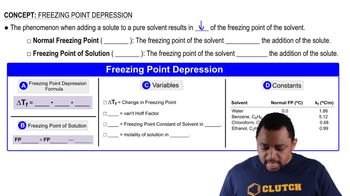Here are the essential concepts you must grasp in order to answer the question correctly.
Colligative Properties
Colligative properties are physical properties of solutions that depend on the number of solute particles in a given amount of solvent, rather than the identity of the solute. These properties include boiling point elevation, freezing point depression, vapor pressure lowering, and osmotic pressure. Understanding colligative properties is essential for determining how solute concentration affects the physical state of a solution.
Recommended video:
Freezing Point Depression
Freezing point depression is a colligative property that describes the decrease in the freezing point of a solvent when a solute is added. The extent of freezing point depression is directly proportional to the molality of the solution and the van’t Hoff factor (i), which accounts for the number of particles the solute dissociates into. This concept is crucial for calculating the freezing point of solutions.
Recommended video:
Freezing Point Depression
van’t Hoff Factor (i)
The van’t Hoff factor (i) is a dimensionless number that represents the number of particles into which a solute dissociates in solution. For ionic compounds like K2SO4, which dissociates into multiple ions (2 K+ and 1 SO4^2-), the van’t Hoff factor is greater than 1. Calculating i is vital for accurately applying colligative property equations, such as those used to determine freezing point depression.
Recommended video:




